
08 Abr Hacks for mastering Q-banks for your USMLE Step 1, USMLE Step 2CK, USMLE Step 3, MCCQE-1, or any other medical licensing exam!
Our Q-Banks serve as essential tools in the academic arsenal of numerous doctors and medical students, assisting them in training for assessments like the USMLE Step 1, USMLE Step 2CK (Clinical Knowledge), USMLE Step 3, MCCQE -1 or any other test to obtain a medical license. Our question banks offer valuable self-assessment opportunities, enabling doctors and medical students to identify their strengths and weaknesses in the relevant content. Whether gearing up for assessments like USMLE Step 1, USMLE Step 2CK (Clinical Knowledge), USMLE Step 3, MCCQE-1, or any other licensure examination, explore our resources below for effective strategies for leveraging Q-Banks.
Top 3 reasons to start using our Q-Banks early:
- Starting to use our Q-Banks early to prepare for USMLE Step 1, USMLE Step 2CK (Clinical Knowledge), USMLE Step 3, MCCQE -1, or any other test to obtain a medical license gives you more practice for the actual test.
- Going through more than 2000 questions in our Q-Banks before taking the USMLE Step 1, USMLE Step 2CK (Clinical Knowledge), USMLE Step 3, MCCQE -1, or any other test to obtain a medical license, you will gain a lot of confidence to present the real test.
- Physicians or medical students who start using our Q-Banks earlier are not only able to increase the number of questions they go through but also increase the speed at which they can answer different questions.
Discover our Q-Banks containing more than 4999 questions crafted by practicing physicians. These questions are derived from realistic clinical cases and are of similar or even higher difficulty levels compared to the actual test.
How to use our Q-Banks?
More than 95% of medical students, foreign doctors, and various specialist physicians like anesthesiologists, internists, ICU doctors, surgeons, and pediatricians, among other specialties, will utilize a Q-Bank while getting ready for exams like USMLE Step 1, USMLE Step 2CK (Clinical Knowledge), USMLE Step 3, MCCQE-1, or any other medical licensing test.
At Doctor en USA, we will demonstrate how our Q-Banks are structured and the most effective methods for utilizing them.
To enhance your understanding, we will provide you with an actual question from our Q-Bank.
Here we go …
1. Begin by concentrating on the essence of the question and identifying the specific area under evaluation. Read the following clinical case.
A 79-year-old woman with no significant medical history was transferred to a tertiary hospital after being hit by a car while walking on the road. On arrival, she was pale and significantly distressed and exhibited the following signs of shock: Glasgow Coma Scale 12, respiratory rate 25 breaths/min, heart rate 99 bpm, and blood pressure 42/28 mm Hg. Fluid resuscitation was started immediately, and tracheal intubation was performed due to suspected severe hemorrhagic shock. Simultaneously, a massive transfusion protocol was initiated, which enabled the infusion of red blood cells and fresh frozen plasma 30 min after the patient’s arrival. A physical examination did not reveal any pronounced head, neck, chest, abdomen, or pelvic traumas other than an obvious deformity of her right lower extremity associated with an open wound. Six hours after her arrival, following her recovery from hemorrhagic shock, the patient’s posterior region was assessed, which resulted in the detection of multiple subcutaneous hematomas covering an extensive area of her lower back. Chest X-ray and ultrasound examinations excluded a cavitary hemorrhage and intrathoracic, intra-abdominal, or pericardial effusion, and a pelvic X-ray showed that the patient’s fractures were stable. A contrast-enhanced whole-body CT scan detected multiple regions of subcutaneous contrast extravasation in her lower back (see image), fracture of the first lumbar vertebra, a left-sided psoas hematoma associated with multiple fractures of the transverse processes of her lumbar vertebrae, and open fractures of her left lower extremities, were also identified. After stabilizing the patient, the medical team, consisting of anesthesiologists, surgeons, ICU doctors, and others, discusses the case to address hemostasis and plan the necessary steps to prevent blood loss post-injury in this patient. The team identifies two main phases of hemostasis: primary and secondary. What statement accurately describes primary hemostasis?
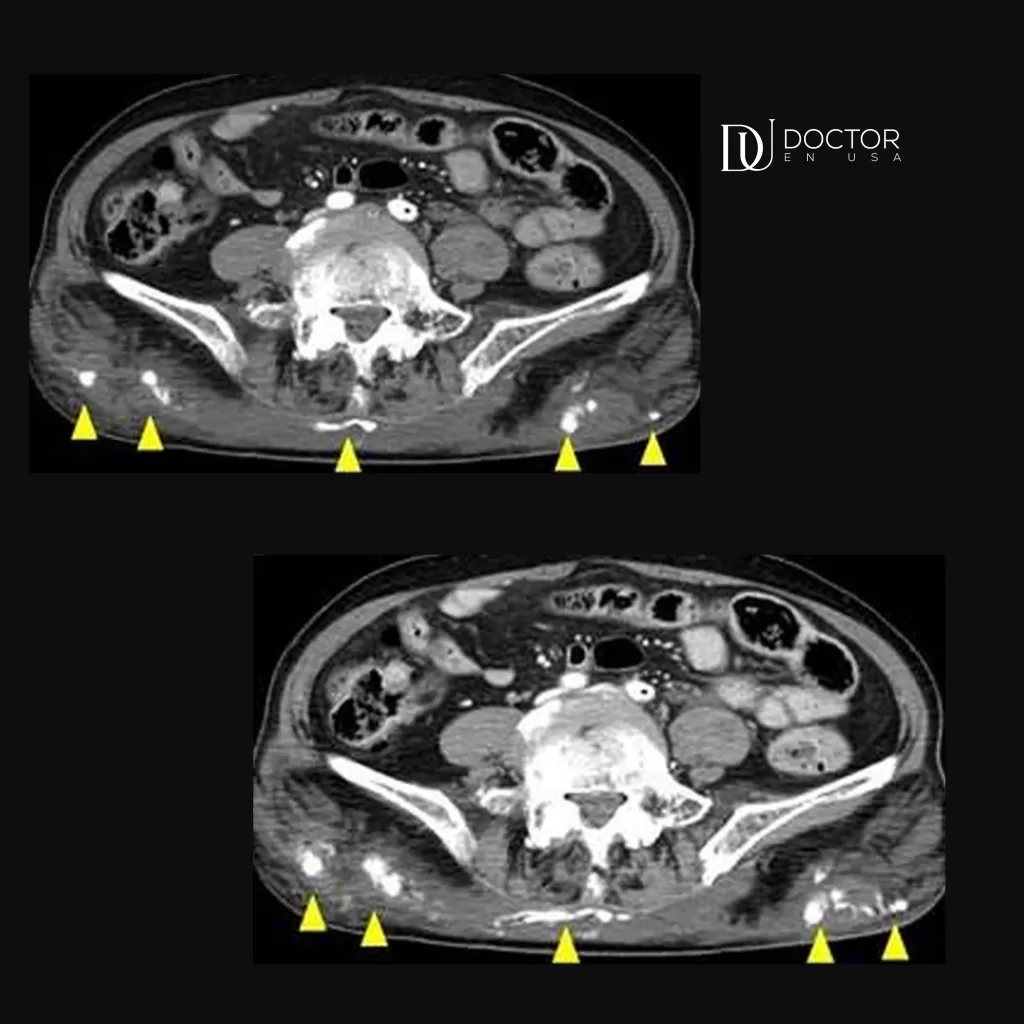
A. Following trauma-induced endothelial damage, vasodilation is triggered.
B. When ADP is released from activated platelets, it binds to P2Y12 receptors on neighboring platelets, resulting in increased expression of GpIIb/IIIa.
C. Fibrinogen facilitates platelet aggregation through GpIIa receptors.
D. Platelet adhesion at the injury site occurs through binding to von Willebrand factor (vWF) with the help of GpIIb/IIIa receptors.
E. When ADP is released from activated platelets, it binds to P2Y12 receptors on neighboring platelets, resulting in increased expression of GpIb.
F. When calcium is released from platelets, it binds to P2Y12 receptors on nearby platelets, leading to enhanced expression of GpIb.
G. Fibrinogen facilitates platelet aggregation through GpIIc receptors.
2. We have now identified that the primary focus of the question centers on “hematology,” with a specific emphasis on the “coagulation mechanism«.
3. Concentrate all your efforts and expertise on understanding the “coagulation mechanism.” Put aside other medical fields such as surgery, cardiac pathology, infectology, microbiology, etc. Remember, focus on one question at a time. The key is prioritizing the current question over the previous or subsequent ones.
4. Now, try to respond using the earlier technique without referring to the correct answer and explanation below.
Remember:
- It’s okay if your answer isn’t the correct choice; it’s all part of the learning process.
- Making a mistake is also a way to learn – you’ll discover a new concept, identify any weaknesses, or realize where you need to delve deeper.
- If your answer was correct, CONGRATULATIONS! Keep up the great work.
5. Let’s review whether we are on the right track or not. Remember, making mistakes in this scenario is beneficial, as it helps us learn and gather fundamental concepts for the real test.
“Correct answer: When ADP is released from activated platelets, it binds to P2Y12 receptors on neighboring platelets, resulting in increased expression of GpIIb/IIIa«.
Here you have a brief explanation to strengthen your knowledge:
Hemostasis is the physiological reaction to vascular endothelial damage, which results in a sequence of processes that try to retain blood within the vascular system through clot formation. Hemostasis can be separated into primary and secondary hemostasis. Primary hemostasis, which forms a soft platelet plug, involves vasoconstriction, platelet adhesion, activation, and aggregation (see image below).

Primary hemostasis begins when the endothelium of a blood vessel is injured. The first reaction includes vasoconstriction to stop further blood loss, activated by neural reflexes and endothelin released from the damaged endothelial cells. When endothelial cells are injured, they reveal subendothelial collagen. This collagen binds to the von Willebrand factor (vWF) released from the damaged cells. Consequently, this initiates adhesion, activation, and aggregation of platelets.
1. Adhesion: Platelets attach to vWF, anchored to the subendothelial collagen at the injury site, through GpIb receptors on the platelets (see image below).

2. Activation: Upon binding to vWF and becoming activated, platelets experience a structural change and release calcium, ADP, and thromboxane A2. ADP attaches to the P2Y12 receptors on neighboring platelets, stimulating the expression of GpIIB/IIIA receptors on the platelets (see image below).
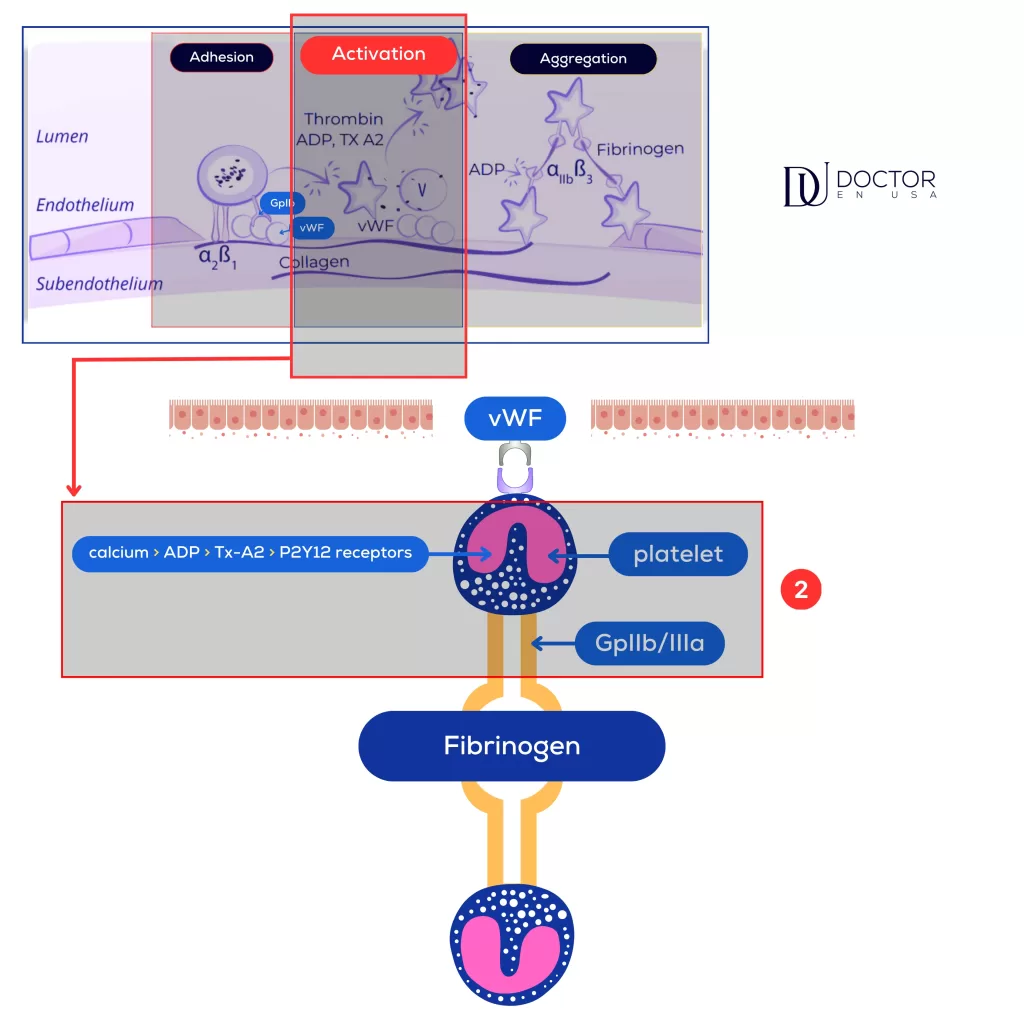
3. Aggregation: Subsequently, with GpIIB/IIIA receptors on the platelets, fibrinogen binds to these receptors, facilitating platelet aggregation. This process combines platelets to form a plug, concluding primary hemostasis (see image below).
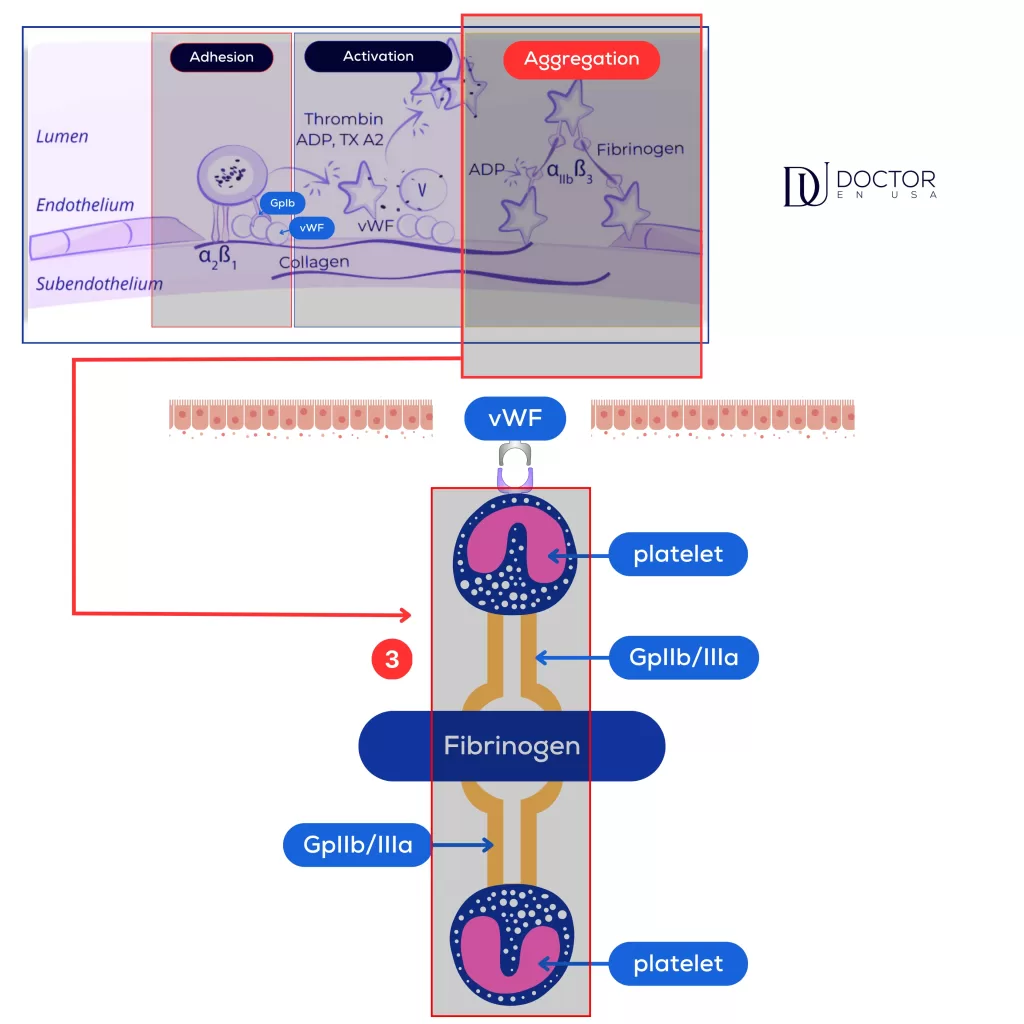
Secondary hemostasis is primarily defined as the formation of fibrinogen into fibrin, which ultimately evolves the soft platelet plug into a hard, insoluble fibrin clot. Within primary and secondary hemostasis, three coagulation pathways exist: intrinsic, extrinsic, and common.
Both intrinsic and extrinsic pathways meet at a shared point to continue coagulation, the common pathway. Clotting factors involved in the intrinsic pathway include factors XII, XI, IX, and VIII. Clotting factors involved in the extrinsic pathway include factors VII and III. The common pathway includes clotting factors X, V, II, I, and XIII.
Once the soft clot of platelets forms, the activation of Factor XII initiates the intrinsic pathway by coming into contact with subendothelial collagen. Simultaneously, the extrinsic pathway is triggered by the release of tissue factor, setting off both pathways until the common pathway is activated through Factor X (refer to the image below).
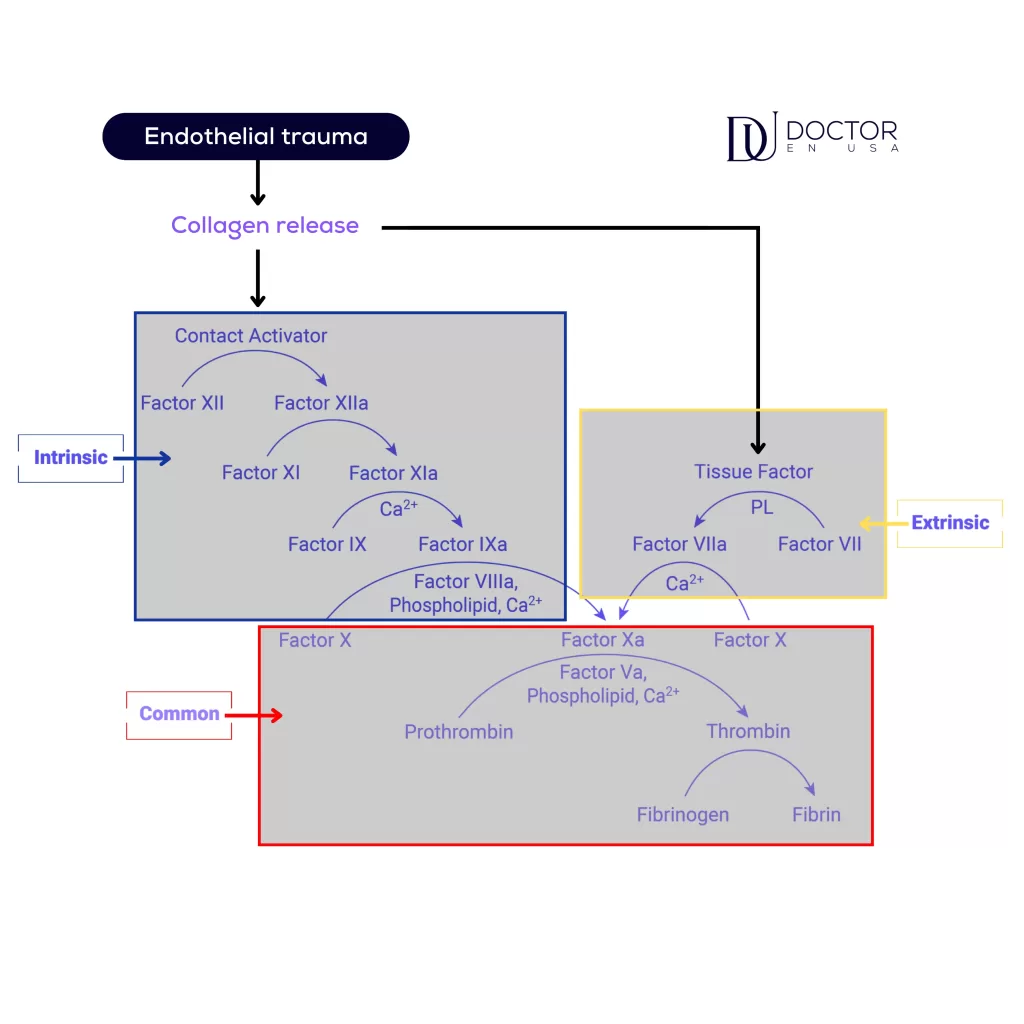
Activating the common pathway aims to release fibrin, which binds around the soft clot of platelets to form a hard clot (see image below).
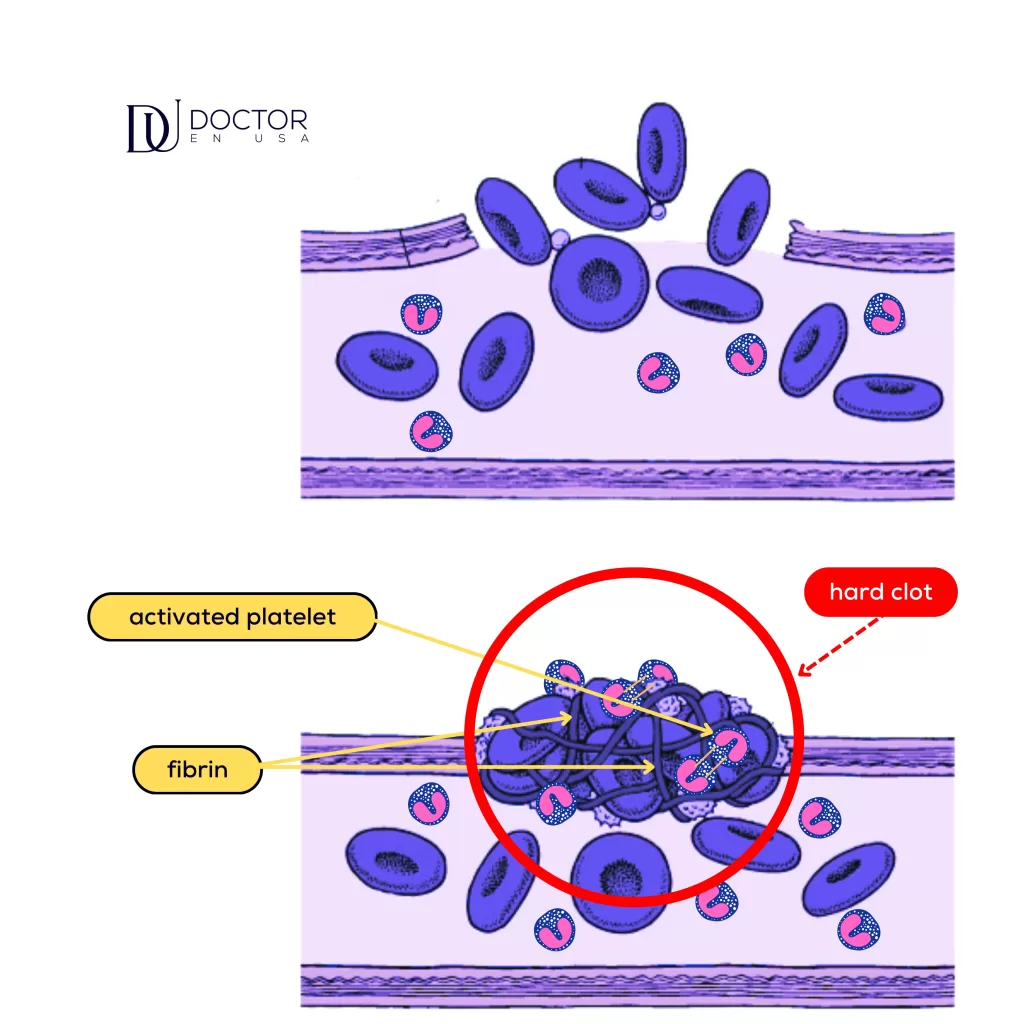
Feedback:
The following options:
- When ADP is released from activated platelets, it binds to P2Y12 receptors on neighboring platelets, resulting in increased expression of GpIb.
- When calcium is released from platelets, it binds to P2Y12 receptors on nearby platelets, leading to enhanced expression of GpIb.
They are referring to an identical concept.
Upon binding to vWF and becoming activated, platelets experience a structural change and release calcium, ADP, and thromboxane A2. ADP attaches to the P2Y12 receptors on neighboring platelets, stimulating the expression of GpIIB/IIIA receptors (not GpIb) on the platelets.
The following options:
- Fibrinogen facilitates platelet aggregation through GpIIa receptors.
- Fibrinogen facilitates platelet aggregation through GpIIc receptors.
They are referring to an identical concept.
Fibrinogen facilitates platelet aggregation through GpIIb/IIIa receptors (not GpIIa or IIc).
– Following trauma-induced endothelial damage, vasodilation is triggered: Hemostasis can be separated into primary and secondary hemostasis. Primary hemostasis, which forms a soft platelet plug, involves vasoconstriction (not vasodilatation), platelet adhesion, activation, and aggregation
– Platelet adhesion at the injury site occurs through binding to von Willebrand factor (vWF) with the help of GpIIb/IIIa receptors: After the endothelial injury, vWF attaches to the subendothelial collagen. Subsequently, platelets adhere to vWF through GpIB receptors (not GpIIb/IIIa).
- Doctor en USA provides an extensive range of subject-specific tests via their Q-banks. These tests offer detailed explanations and high-quality illustrations for correct and incorrect answers. While users can choose tests from any subject at their discretion, we recommend adhering to the suggested order presented within the platform. Each subject commences with a five-question test, followed by progressively more challenging tests, culminating in 40 questions each.
- While users may choose to take tests in any order, we strongly recommend beginning with the first test of the first subject and proceeding in order until all tests within the same area have been completed. Additionally, Doctor en USA‘s Q-banks offer infinite self-assessment exams per subject, classified according to their level of intensity (high, intermediate, or low). These exams serve as diagnostic tools to measure progress and assess skill levels.
- Subscribers to Doctor en USA‘s Q-banks are granted unlimited access to many tests throughout their subscription. Furthermore, users can flag questions for review by selecting the checkbox beside the designated red flag icon during testing or review.
- Following every test or self-assessment conducted using Doctor en USA‘s Q-banks, users will receive a comprehensive report on their performance, including the start and finish time, the time taken to complete the test, and the grade obtained. We recommend that users strive for scores above 85% and work diligently towards achieving this target. Once users consistently achieve this score on all tests and self-assessments, they will be well-prepared to take the real test.
Are you ready to ace your USMLE Step 1, USMLE Step 2CK (Clinical Knowledge), USMLE Step 3, MCCQE -1, or any other test to obtain a medical license? We’ve got the perfect solution for you! Our Q-Banks offer over 4999+ challenging USMLE questions based on real-life clinical scenarios created by practicing physicians with extensive experience. With in-depth explanations, conceptual focus on important preclinical and clinical topics, vivid illustrations to help you master the content, and detailed descriptions of incorrect options, you’ll be perfectly prepared for your test. Get ready to become a USMLE pro with our Q-Banks!
